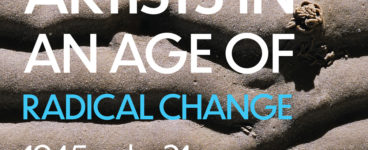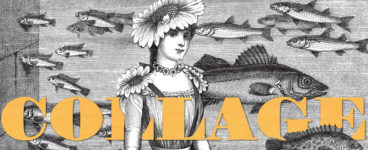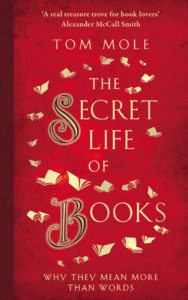‘Our books are leading a double life. As well as being containers of words, they are things imbued with their own significance.’
We’re all book lovers here, right? And we read books for many different reasons – for inspiration, for community, for challenge, for entertainment. Tom Mole takes a look at how books shape our lives, and the myriad ways they do so in his latest release. BooksfromScotland caught up with him to ask him how books in their many ways have shaped him over the years.
The Secret Life of Books: Why They Mean More Than Words
By Tom Mole
Published by Elliot and Thompson
The book as a book. In a reading world of multiple formats, what is your favourite book that celebrates its form as a book?
There are lots of children’s books that do this wonderfully – think of the holes in the pages of The Very Hungry Caterpillar, or the bite marks in Oliver Jeffers’ lovely The Incredible Book-Eating Boy. Sometimes I think it’s a shame that books for adults don’t make as much of their physicality. But my favourite book in this category must be The Life and Opinions of Tristram Shandy, Gentleman, by Laurence Sterne, a mad-cap sendup of an autobiography published in nine volumes from 1759 onwards. Sterne continually draws attention to the thing made of paper and ink that you hold in your hands as you’re reading. He includes a blank page for you to draw your own illustration, a black page that marks the death of a character, and a marbled page that is a ‘motley emblem’ of the novel itself. Sterne reportedly hung around the printing house and gave the compositors precise instructions about how long the dashes should be. On almost every page, you can see that he’s thinking not only about what he wants to say, but about the material form his work is going to take on. The book is flamboyantly physical.
The book as a thing. What is your favourite book as an object?
I’m more of an accumulator of books than a collector of them. I seem to have acquired books as a side effect of reading them rather than as a result of seeking out expensive treasures or rare first editions. But I do have some books that are very special to me. A couple of years ago, I had the privilege of interviewing Kathleen Jamie in front of an audience at the University of Edinburgh. We talked about the forms her writing has taken in different kinds of books. Afterwards, she gave me a signed copy of her beautiful limited-edition book This Weird Estate, which is a series of poems inspired by images from the collections of the Royal College of Surgeons in Edinburgh. It’s a lovely memory of the occasion, as well as being a remarkable object.
The book as yourself. What is your favourite book that has informed how you see yourself?
Lots of people have a book that marked their coming of age as a reader. For me, this was Lord Byron’s comic epic poem Don Juan, which I read in the Penguin paperback edition when I was still at school. The book is long – over 700 pages – and so I carried it around for ages. It taught me that poetry could be laugh-out-loud funny, even when it was full of serious subjects. I’m still in awe of Byron’s sheer technical ability as a poet. I went on to study Byron and write about Don Juan, and I kept on re-reading this book until the pages started to fall out. I’ve acquired other copies of the poem over the years, but my first copy still has a special place on my shelves. More than any other book, it was the catalyst for a lifetime of reading and thinking about literature.
The book as a relationship. What is your favourite book that bonded you to someone else?
I didn’t inherit any books, but after my Grandfather died my brother and I went into his flat and took one or two things each. I ended up with an overcoat that I’ve worn quite a lot, even though it doesn’t really fit me, and a copy of Andy McNab’s Gulf War memoir Bravo Two Zero. The book didn’t really fit me either – I would never have picked it up in a bookshop, and the only reason I pulled it off my Grandad’s meagre bookshelf was because it seemed marginally more appealing than the Reader’s Digest abridgements on either side. I read the book in any case, and I’ve kept it ever since. As I was reading, I often wondered whether my Grandad had enjoyed the book, and what he’d thought of it. But by then it was too late to ask.
The book as your life. What is your first memory of books and reading?
Our house wasn’t full of books – my parents had no bookshelves of their own. But we did have stacks of ladybird books, and slowly these stopped being something my mother read aloud, and became something my brother and I could read for ourselves. I distinctly remember one occasion – I suppose I must have been six or seven – when I read one of these books through from beginning to end in one sitting by myself. And I thought to myself, I can read now. I’m not learning how to do it, I can do it.
The book as technology. Reading now occupies the digital landscape as much as the physical world. What books are your favourites as eBooks or audiobooks?
Although I read quite a lot on the screen for work, I haven’t got used to reading eBooks for pleasure yet. I think the connection between the eyes, the hands, and the printed page is too deeply ingrained for me to migrate easily to another format. It would be like asking a pianist to play on an instrument where all the keys have been rearranged. But my daughter is an avid listener to audio-books, and some of these have been a revelation. Fiona Shaw’s reading of Alice in Wonderland is a terrific piece of interpretative art in its own right, and has certainly enhanced my appreciation of Lewis Carrol’s book. I also loved David Tennant’s reading of the How to Train your Dragon books by Cressida Cowell.
The book in the future. Do you have any thoughts on the next manifestation of reading?
Books are changing, and reading is changing with them. The form of the book shapes and informs the way you respond to it, and so when the form changes, your response changes as well. Perhaps for the worse. There’s some evidence that people don’t understand as well or remember as much when they read on screens compared to when they read on paper. I think it’s too soon to say for sure – maybe a new generation that have always read screens alongside pages will be able to switch between the two with ease. Books have taken many forms in the past, from papyrus scrolls to parchment codices and from leather-bound volumes to mass-produced paperbacks, so the book can adopt new technologies and adapt to new media environments with ease. I’m more concerned about how reading will be changed by the conditions of constant distraction we now inhabit, when more and more of us are reading on devices that constantly offer the possibility of turning aside from our reading to pay attention to something else.
Finally, what are you looking forward to reading next?
Like most readers, I have a large pile of books waiting for me. Actually, it’s so large that it’s spawned several sub-piles. I don’t like to look at them too closely, because they remind me of good intentions left unfulfilled, and opportunities not yet seized. Far more fun to ignore those ziggurats of worthy volumes and breeze into a bookshop, pick up something that takes my fancy and start reading it on the bus home. No matter how many I read, there always seems to be another P.G. Wodehouse or Agatha Christie to enjoy. The trouble is that everything I read leaves me with its own list of further reading. David Mitchell’s Cloud Atlas led me to his Thousand Autumns of Jacob de Zoet, and now I have The Bone Clocks on my bedside table. Meanwhile, my daughter keeps telling me I have to read the Katherine Rundell books she’s obsessed with. There’s no end to it….
Tom Mole’s The Secret Life of Books: Why they Mean More than Words is published by Elliott & Thompson, priced £14.99.
ALSO IN THIS ISSUE

 Scottish Art in an Age of Radical Change
Scottish Art in an Age of Radical Change
‘We wanted to experiment, try things out and see where they might lead. We still don’t know if what …

 Cut and Paste
Cut and Paste
‘All of a sudden, the age-old relationship between the subject and the artist’s representation of it …













